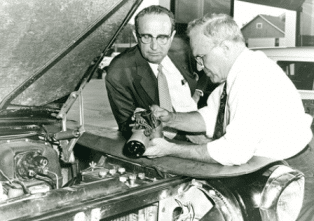Engineers are exceptionally skilled at designing products that assist people who are disabled. But it’s not often that we see a disabled person engineering for those who are able-bodied.
While millions of people use cruise control every day, many wouldn’t know that it was invented by a blind engineer. His name was Ralph Teetor.
When he was five-years-old, he was blinded in an accident involving a knife. He then suffered from sympathetic ophthalmia — the other eye went blind as a result of the trauma to the first.
Ralph had a knack for engineering from an early age. He would tinker with parts in his father’s workshop, from ten-years-old. He developed a talent for feeling mechanical objects and designing parts despite his disability. His hands had become his eyes. He believed he could have a future in engineering.
 Source: Smithsonian Magazine
Source: Smithsonian Magazine
After high school, many universities refused his applications based on his disability. Nonetheless, he eventually got enrolled at the University of Pennsylvania in the mechanical engineering department.
He graduated from university and went to work in the U.S. Navy, where he performed engineering maintenance on warship steam turbines. After leaving the Navy, his father and three of his uncles recruited Ralph for their piston ring production company named Perfect Circle. He eventually became the President of the company and tinkered away on his own small projects too.
He also became the President of the Society of Automotive Engineers (SAE).
During World War 2, war rationing forced motorists to drive 35 miles-per-hour so that they could save on gas. Consequently, Ralph began work on a mechanism that could assist motorists in sticking to one speed during a commute, without having to regulate it themselves.
In 1948, the ‘Speedostat’ was born. A decade later, they finally finished engineering a prototype that could confidently be used in vehicles.
The first prototype included a vacuum-driven piston capable of stopping the gas pedal from being pushed far enough.
Nonetheless, true cruise control would have to keep the driver at a constant speed, not just slow it down. That’s when Ralph added a ‘speed lock’ mechanism with the help of an electromagnetic motor. Upon the tapping of the breaks, the speed lock would be canceled out.
By 1958, Chrysler wanted the Speedostat in their cars and started adding it as an option to their luxury cars. By the 1960s, all General Motors’ Cadillacs had it – and its name changed to ‘cruise control.’ Then in 1973, when the Organization of Arab Petroleum Exporting Countries (OPEC) decided to stop selling oil to the United States due to political factors at the time, cruise control was lauded as an oil-conserving savior.
Ralph Teetor’s legacy proves that despite disability, engineers can defy the odds and create something that completely revolutionizes technology and improves lives. It shows that anyone can overcome a setback and still contribute to humankind.
The invention of cruise control made people wonder how much further vehicles could be automated at the time. Fast forward to today, and we are on the verge of driverless cars.
Works Cited
“The Inventor of Cruise Control Couldn’t See.” YouTube, 31 July 2018, youtu.be/298Rb9wNwMg.
Sears, David. “The Sightless Visionary Who Invented Cruise Control.” Smithsonian.com, Smithsonian Institution, 8 Mar. 2018, www.smithsonianmag.com/innovation/sightless-visionary-who-invented-cruise-control-180968418/.


